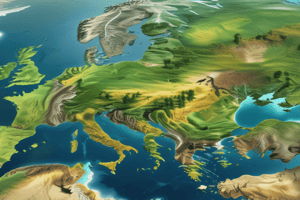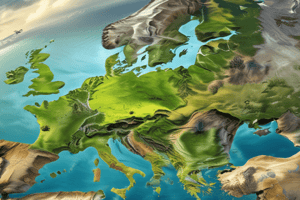Podcast
Questions and Answers
What was a significant factor that shaped the population patterns in Northern Europe?
What was a significant factor that shaped the population patterns in Northern Europe?
- Rising birth rates
- Migration and ethnic groups (correct)
- Enhanced naval capabilities
- Expansion of agricultural land
Which country was dominant in the Kalmar Union during the 1300s?
Which country was dominant in the Kalmar Union during the 1300s?
- Sweden
- Denmark (correct)
- Norway
- Finland
Which development in the 19th century led to the creation of new social classes in the Nordic countries?
Which development in the 19th century led to the creation of new social classes in the Nordic countries?
- Religious reforms
- Territorial expansions
- Industrialization (correct)
- Colonial endeavors
What characteristic of Nordic countries' governance is shared by all of them?
What characteristic of Nordic countries' governance is shared by all of them?
Which group is considered the native people of northern Norway, Sweden, and Finland?
Which group is considered the native people of northern Norway, Sweden, and Finland?
What process describes the rise of land masses that were depressed by ice sheets during the last ice age?
What process describes the rise of land masses that were depressed by ice sheets during the last ice age?
Which feature is characterized by long, steep-sided valleys now filled by seawater?
Which feature is characterized by long, steep-sided valleys now filled by seawater?
What type of climate covers most of the northern half of Scandinavia?
What type of climate covers most of the northern half of Scandinavia?
What form of geothermal energy is described as a spring that intermittently ejects jets of heated water and steam?
What form of geothermal energy is described as a spring that intermittently ejects jets of heated water and steam?
Which of the following regions is known for its vast coniferous forests?
Which of the following regions is known for its vast coniferous forests?
What mineral resources are commonly found in Finland?
What mineral resources are commonly found in Finland?
Which country generates electricity primarily from renewable wind power?
Which country generates electricity primarily from renewable wind power?
What natural feature resulted from glaciers scouring rich topsoil in the Scandinavian Peninsula?
What natural feature resulted from glaciers scouring rich topsoil in the Scandinavian Peninsula?
Flashcards
Continental Rebound
Continental Rebound
The upward movement of land masses that were previously pressed down by the weight of ice sheets during the last ice age.
Fjord
Fjord
A long, narrow, deep inlet of the sea between high cliffs, typically formed by the erosion of a glacier.
Geothermal Energy
Geothermal Energy
A form of energy conversion that captures heat energy from within the Earth.
Hot Springs
Hot Springs
Signup and view all the flashcards
Geyser
Geyser
Signup and view all the flashcards
Arctic Tundra
Arctic Tundra
Signup and view all the flashcards
North Atlantic Current (Gulf Stream)
North Atlantic Current (Gulf Stream)
Signup and view all the flashcards
Subarctic Climate
Subarctic Climate
Signup and view all the flashcards
Viking Age (793-1050 A.D.)
Viking Age (793-1050 A.D.)
Signup and view all the flashcards
Kalmar Union (1300s)
Kalmar Union (1300s)
Signup and view all the flashcards
Continentalization
Continentalization
Signup and view all the flashcards
Sami People
Sami People
Signup and view all the flashcards
19th Century Industrialization in Nordic Countries
19th Century Industrialization in Nordic Countries
Signup and view all the flashcards
Study Notes
Physical Geography of Northern Europe
- Northern Europe's landscapes are heavily influenced by glaciers, tectonics, and climate.
- Glacial activity sculpted fjords (long, deep valleys filled with seawater) and created continental rebound.
- Norway and northern Sweden are mountainous, with many fjords along the Atlantic coast.
- Finland is largely flat, with scattered hills and mountains, and numerous offshore islands.
- Iceland is an island nation with high volcanic activity, frequent earthquakes, and geothermal features (geysers, hot springs).
- Glaciers have stripped much of the topsoil from the Scandinavian Peninsula, creating many lakes and making river travel challenging.
- The North Atlantic Current moderates climate to create mild temperatures even at high latitudes and creates a marine west coast climate/vast coniferous forest in parts of Sweden.
- Regions in the far north experience Arctic tundra conditions characterized by extreme cold, frozen ground and limited vegetation.
- This region's animals migrate to warmer areas during winter.
- Subarctic climate is predominant in the northern Scandinavia with milder humid continental climate in Southern Scandinavia and Finland.
- Finland has abundant peat deposits, which are harvested and used as fuel.
- Northern Europe's mineral resources include iron ore, nickel, zinc, and copper.
- Hydroelectric power is generated utilizing rivers.
- Norway and Denmark have significant oil and natural gas reserves in the North Sea.
Climate Patterns in Northern Europe
- Latitude, mountains, wind patterns, and proximity to bodies of water influence climate patterns.
- The North Atlantic Current (Gulf Stream) significantly affects climate, creating mild temperatures at high latitudes.
- Arctic tundra climates are found in the extreme north, characterized by dry, poor soil, extreme cold, and limited vegetation.
- Subarctic climate predominates throughout much of northern Scandinavia.
- Southern Scandinavia and Finland experience a humid continental climate.
- The Atlantic coast and Southern Sweden have marine west coast climates.
Resources and Economy of Northern Europe
- Finland's economy relies heavily on forest products.
- Peat is a significant resource for fuel in Finland.
- The region has mineral resources including iron ore, nickel, zinc, and copper.
- Hydroelectric power is utilized.
- Norway and Denmark have notable oil and natural gas reserves.
- Renewable wind energy is utilized in Denmark.
Human Geography of Northern Europe
- Similar societies and cultural traits are found in Nordic countries.
- Scandinavian Vikings, during the Viking Age (793-1050 AD), raided coastal areas of Europe.
- Norway's geography (coasts, mountains, fjords) shaped Viking societies.
- Christianity's introduction to Northern Europe was gradual.
- The Kalmar Union (1300s) united Denmark, Norway, Iceland, and Sweden, with Denmark holding dominance.
- Increased trade and contact with mainland Europe led to more continental cultural influences and ideas.
- Industrialization in the 19th century caused population growth and new social structures.
- Democratic parliaments are common in the region.
- The Sami are the native people inhabiting northern Norway, Sweden, and Finland.
- Immigration to Northern Europe has increased from various regions, including war-torn areas of Africa.
Studying That Suits You
Use AI to generate personalized quizzes and flashcards to suit your learning preferences.




